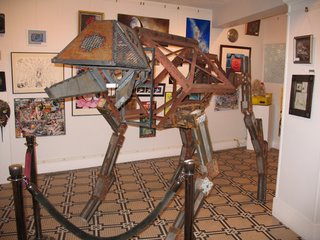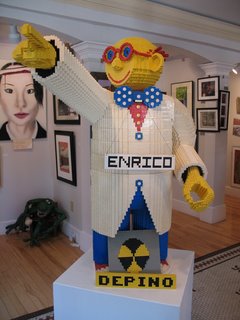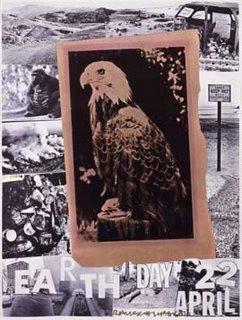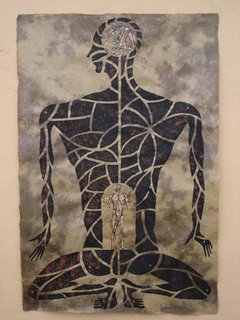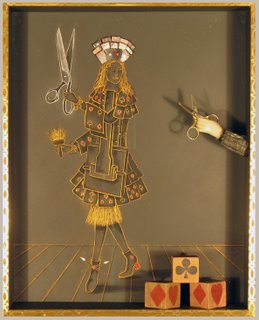On the Roadside Attractions
Kehler Liddell Gallery
873 Whalley Ave., New Haven, (203) 389-9555
Roadside Attractions
Feb. 3—Feb. 25, 2007.
Closing reception Sun., Feb. 25, 12—2 p.m.
With apologies to Jack Kerouac
It's twilight in redbrick America, where all the boys and girls have gone to bed by the blue LCD glow of the all-seeing cyber eye. But out on the road the rust of time eats at steel and the sun rises and sets on workaday lives, sweetly dreaming of cotton candy and love letters.
Darkness was closing in on the fairgrounds as the photographer pulled into Stratford ("127-042-042, Stratford, CT," Paul Duda). Standing at the edge of the playground, desolate of the yap of muss-haired children, watching the ferris wheel circle. Do they believe in sea monsters in the land of helicopters? Because we swear we see one in the time-preserved image, thrusting its long neck out of the asphalt sea, its head flat like a basketball backboard.
If sea monsters exist only in play dreams of boys and girls, sitting on the stoops of summer and reading the clouds like comic books, then what do we make of Eeka the Jungle Creep ("Ginger is Eeka," Gale Zucker)? The ID bracelet encircling her wrist, rings on her fingers, a giant snake wrapped around her like the embrace of time. Oh, America, your world of individuals fast disappearing in strip mall conformity, the cookie-cutter corporate stamp stomping out the sideshow.
Does time embrace us like a snake or does it rush past us, a harried commuter with mid-afternoon whiskey breath and unanswered emails from his mistress on his brain and BlackBerry, blackberry brandy, buying high and selling low while the dust to dust earth beckons, the time full-stop accelerating like the last Metro North train out of Grand Central? ("Dromos II, I-95 Corridor from New Haven, CT to Miami FL," mixed media photo collage by Johanna Bresnick) The blackness curves, cuts corners. We grab our coffee, morning bitter, in New Star Diners, toppled sign with daily specials, and rush past billboards, fraying like modern art with a dozen unremembered sales pitches, fastballs to the commercial brain. Can you smell the chemicals in the blue sky air, streaked with nylon, while you swing the day away in old tires far from the Jersey barriers of life? Spare a dime for a pay phone, orphaned by cell technology, looking lonely like the last union assembly line worker in the shuttered auto plant. Put the pedal to the metal and let the rust be blasted away by forgetting, watching the sun burn our pupils as it screams—sizzling haze—through the palm trees. We leave the shiny dying steel deco of the Northeast for the curved faux deco of Florida and wonder, will the future decay like the past?
We're flooded with memories. Waters in our dreams. Can we catch our breath, reach the surface? Water rushing in all around. Biblical. And then waters recede and we need a jazz funeral for a city. Death and debris is left in the backwash. Orange chairs and plaid sofas in a pile of wood and rot on the industrial roadside ("Debris," Marion Belanger). A streetlight yanked over in submission to the hand of an angry wind, embarrassed next to the now placid, once devouring water ("Lake Front, Louisiana-Post-Katrina," Stan Strembicki).
But if a tree can grow, gnarled and twisted and mute through a wood frame painted red with a maw of pointy teeth ("Framed Tree," Phyllis Crowley), then we can force our heads through hurricane despair. And laugh. Laugh in the hustle bustle city where the backwards baseball cap skateboarder ("Street Surfer," Hank Paper) faces off against trio of blue bedecked Finest. And Dr. Ruth rubs her hands in glee while Ms. Yuppie in her black dress and designer sunglasses and pocketbook eyes the hardhat worker in his sleeveless t-shirt, sex trumping class in the sunny day ("Dr. Ruth," Hank Paper).
What's holy in our black-and-white eye's remembrance? We climbed the hills overlooking redbrick Brass City to worship at the altar of kitsch in our age of innocence ("Holy Land, Church," Joy Bush). And when our innocence was gone, the brush reclaimed the earth, reclaimed the Land, leaving only the Holy and we wonder why and scrawl across the Y ("Holy Land," Joy Bush) in furtive shorthand, "Manchester." Religion guards its mysteries. Ruins are our new religion, the dirty stucco concrete house of worship where the lambs of the faith await the slaughter. Amen.
There will be a closing reception for Roadside Attractions at the Kehler Liddell Gallery on Sun., Feb. 25, 12—2 p.m. The accompanying show at the Small Space Gallery closes Mar. 16.


